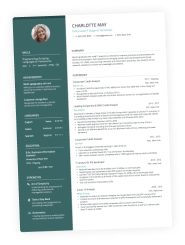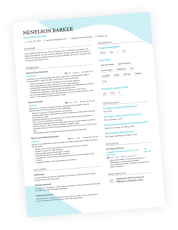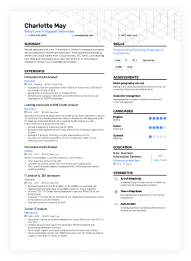6 seconds.
That’s how long it takes for recruiters to decide whether you’re suitable for the job or not.
This means one thing. You don’t have much time to make a strong first impression.
You need to ensure that the recruiter will get an understanding of what you bring to the table with just a skim of your CV.
But that wouldn’t be possible if the crucial details about your job history, skills, and awards are all over the place.
Your CV needs to follow a certain logic. It needs to have a specific structure.
Is this structure job-specific? Not necessarily.
Surely there are some sections software engineers need to have that office managers can omit.
But generally speaking, the structure of your CV wouldn’t vary much regardless of the position you’re applying for.
In this article you’ll learn:
- What the 3 most common types of CV formats are
- How to structure your CV in an engaging yet easy-to-read way
- What sections your CV can’t go without
- Why using action verbs on your CV boosts your chances of landing an interview
… and more!
Is your resume good enough?
Drop your CV here or choose a file. PDF & DOCX only. Max 2MB file size.
The 3 most common CV formats and why choosing the right one makes a difference
Several years ago, CVs could be a plain .docx document with a couple of bullet points under each section.
Nowadays, however, hiring managers expect more.
Imagine the number of applications they go through every single day. It’s not so hard to understand why they value proper-structured CVs.
To make things easy for you, let’s look at the top 3 different CV formats we advise you to choose from.
Reverse-chronological CV format
The reverse-chronological format speaks for itself. As the most common CV format, it plays directly with recruiters’ sense of familiarity.
When choosing this format, you’d be expected to start with your most recent position and move backward.
The reverse-chronological format would fit candidates with 3-10 years of professional experience who have been through at least 2-3 positions.
Naturally, this makes it unsuitable for recent graduates or applicants with big employment gaps.
Another thing to keep in mind when discussing the reverse-chronological CV format is the fact that it focuses mainly on work experience.
So if you want your CV to be more creative or achievement-oriented, then there is a better option to go for. It’s called the functional CV format.
Functional CV format
Functional CVs are best for students, recent graduates, or people with large gaps in their work experience.
They focus on skills, achievements, and talents, rather than work experience. These three sections are usually put at the top of the CV, with work experience being put right at the bottom.
The point of the functional CV format is to prove you have all the necessary skills to do well in the job. Even if you don’t have the experience for it.
And if you’ve been unemployed for a while but don’t want to put the emphasis on this… then you’re in the right place. Showcasing your skills, certificates, and accomplishments is the go-to option for many job-seekers who are in the same boat as you.
If neither of these two options sounds suitable for you - don’t worry about it. The hybrid CV format is here to save the day.
Hybrid CV format
The hybrid CV combines the best of the reverse-chronological and the functional formats.
It follows a reverse-chronological order for listing your previous jobs while leaving enough room for important sections such as achievements, skills, and certificates.
This makes it perfect for professionals with up to 5 years of experience. Or generally for people who want to stand out and are up for a challenge.
You could also include some non-traditional sections, like a ‘What my typical day looks like’ chart or a list of all your favourite books.
The hybrid CV gives you the freedom to make your own choices. Keeping your application professional yet personal.
Now, once you’ve chosen the best format for your resume, it’s time to learn more about the sections recruiters want to see.
The sections your CV cannot go without
Regardless of the format you’ve chosen for your CV, there are some primary sections your CV needs to have.
Including these sections will ensure hiring managers have all the required information to make an informed decision when screening applicants. And ultimately invite you to an interview.
Let’s look at each of these CV sections:
First things first: adding personal details in your CV
When you’re applying for a job, the first thing you need to do is add your personal details.
These go into the header of your CV and include name, phone number, link to your portfolio or LinkedIn profile (depending on the position), and the town you currently live in.
This information is exceptionally important for one single reason: getting in touch with you.
If the hiring manager sees you as a good fit, they’d need to contact you and learn more about who you are as a person.
So make sure your header section doesn’t look like this:
Rather, make sure to always include:
- Your name and surname
- A professional sounding email address (safest bet would be name_surname@website.com)
- Your full job title
- Your phone + country code
- A link to your portfolio or LinkedIn profile, no social media profiles, please!
Here’s a good example to follow:
After you’ve ensured the hiring manager will be able to get in touch with you, it’s time to share with them a little bit more about you and get their interest!
The CV summary: key for a strong first impression
The summary of your CV is the first thing recruiters will see.
It’s your first (and most often only) chance to build a connection.
Yeah, building a connection with someone you can’t see or speak to sounds difficult.
But it doesn’t have to be. If you have a summary that highlights your top strengths and proves you’re the best fit for this job.
So what exactly is the CV summary? It consists of 2 or 3 sentences (tops!) that sit just below the header of your CV.
Here’s an example of a CV summary we’d describe as quite good.
This CV summary lists the candidate’s top 3 skills (related to graphic design, copywriting, and total search) while at the same time putting them in context and showing the results they have led to.
In short - it shows how these skills have been utilised to surpass client goals and lead to great success.
The best any manager can ask for.
And once you have your CV summary ready, it’s time to expand on your achievements and responsibilities in the experience section.
Proving you have what it takes in the experience section
Based on the job you’re applying for and your level of expertise, the experience section can be one of the most important bits of your CV.
Hiring managers want to see how your previous responsibilities relate to the job you’re applying for now.
Which is exactly why you need to be careful with what you discuss here.
We hear you wondering - is there a way to mess up the experience section completely?
Absolutely.
The easiest way to do this is by listing points that have nothing in common with your future job role.
This could be, for instance, by saying you took care of all incoming invoices in the past when you’re actually applying for a job as a truck driver.
Will your finance skills be of any need or help? Most probably not. So there’s no point in including them.
Now, if you want to ensure your experience amazes recruiters and makes them want to hear more from you, we’ve got something for you.
Two words. Action. Verbs.
Use them to describe your responsibilities in a way that gives you all the credit you deserve.
Here’s an example of what your experience section might sound like if you don’t use action verbs:
- •Resource support for a team of 20
- •Invoicing
- •Conflict resolution
And now look at this:
- •Resourced complex tasks based on individual allocation, skills, and availability across a team of 20
- •Ensured all invoices were being sent on time in order to guarantee client satisfaction
- •Dealt with timeline changes quickly and efficiently while sticking closely to pre-agreed budgets
See the difference?
Using action verbs at the beginning of all your bullet points empowers you in a way like no other.
They prove you’re able to take charge. At the same time, they help you highlight what you’re most proud of.
And talking about things you’re proud of, let’s not forget about the skills’ section.
Crafting a skills section that beats ATS
Have you heard of applicant tracking systems (ATS)? They’re used by most recruiters as a pre-screening step.
This means that even before a recruiter gets to look through your CV, this specific type of software has checked whether your application is worth spending time on at all.
How does it do that? By tracking keywords.
Let’s imagine you’re applying for a position in business intelligence. They’d probably want you to be proficient in a BI tool such as Power BI.
And what’s more, they’d probably want to know how you’ve used it and what results this has helped you achieve.
So, the easiest option here would be to ask the ATS to only ‘approve’ CVs that have the keyword ‘Power BI’ in them.
Which means that if your CV doesn’t mention ‘Power BI’, there’s a huge chance of getting rejected. Only because the ATS didn’t deem you the right type of candidate.
Now, we get that this is extremely irritating. You might be a Power BI pro and still get rejected?
Yeah. This is exactly why you need to be mindful of the skills you list on your CV.
Curious to find out more about how ATS can impact your job application? We’ve expanded on this here.
But remember - there’s no point in listing all your skills. Focus on the relevant ones.
A good idea is to go through the job advert (and maybe even some similar job adverts) and see what the desired skills are.
If you have these skills, make sure to add them to your skills section. (But please don’t lie if you don’t.)
And don’t forget - balancing between hard and soft skills is key.
Check this out for an extensive list of key skills to put on your CV.
Showcasing your expertise in the education section
Nowadays, it has definitely become common to see people working in fields they haven’t gained any formal education in.
But! It’s still important to keep in mind that spending 3 years or more studying and researching a field of your choice will make you stand out from someone who has no formal higher education and has instead gained all knowledge through their job.
And even if you don’t hold a university degree, here’s what your job-winning CV education section must include:
Things to include in the education section of your CV
- Your highest education degree - this might be high school or university; if you have more than 1 degree, list them in chronological order
- The institution you attended and the years you spent there
- The awards you have received (e.g. Deans’ list, Top of the class)
- Entry-level position bonus: the relevant classes you’ve taken
Keeping the attention: other sections to include in your CV
Choosing whether to add some other, out-of-the-ordinary sections to your CV depends on several factors.
The position you’re applying for. The company you’re applying for. The industry you’re part of.
If you’re applying for an entry-level position or a position in a more creative and innovation-boosting industry, then you can add some depth to your CV by sharing your favourite quote or speaking about your achievements.
Another section that you can think of as ‘nice to have’ is the certificates section. It’s often used to showcase relevant courses and certification programs you’ve taken to strengthen your skills.
To sum up, here are some additional sections to enhance your CV:
- Hobbies and interests
- Publications
- References
- Volunteer work
- Certifications
- Projects
- Awards
- Achievements
Looking for more tips on how to improve your CV? Here are some examples!
Key takeaways: Structuring your CV like a pro
Though it may seem hard on the surface, structuring your CV is actually quite straight-forward.
If there are only 3 things to remember from this article, these should be:
- The format you choose for your CV should be based on your experience and the industry you’re applying for
- Action verbs will portray you as someone who can take charge and will do whatever is required to achieve their goals
- Not having the right keywords on your CV might result in your application getting rejected by ATS
And if you’re looking for a way to build a personal yet professional CV in just a couple of minutes, make sure to check out our CV templates!



